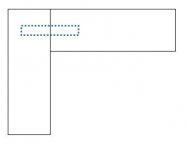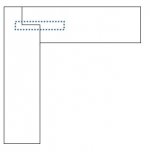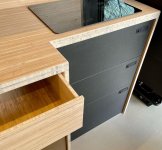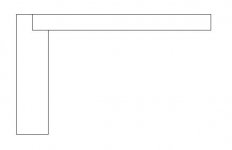Dusty.Tools said:
Is the combination of dowels and confirmats critical or could you double up on confirmats?
I’ve used dowels before and never perfected the alignment. I’m sure I will figure it out if required.
There are a couple of reasons I use the confirmats. The primary reason is it eliminates the need for bar clamps. The second reason is, if clamping diagonally to square things up, there are no other clamps to get in the way.
My process is this:
I cut the boards to size and add slot for back board
I assemble the box using picture framers’ corner clamps (8 clamps) on all four corners front and back.
I drill for the confirmats. For upper cabinets 2 screws per corner. For Lower cabinets three screws per joint.
I check for square and clamp diagonally if required.
Note: When I am using the corner clamps I have never had to clamp diagonally. You can buy corner clamps from Amazon for about $3.00 each.
For more robust construction, I through drill for dowels. Alignment is 100% guaranteed because you are drilling holes for both pieces at the same time. Apply glue and tap dowels into the hole. I drill deep enough that I don’t have to trim the dowels.
Note: With plywood, particle board and MDF (the only materials that were tested by the labs) use no fastener within 2” of the end of the board. You need enough material on either side of the fastener to assure that the boards do not split open. I don’t know if that applies to bamboo boards.
I allow the glue to set before moving.
On projects where I will be finishing after assembly, I will glue the joint as well as the dowels. I am of the opinion that glue will not be very effective on painted or clear coated surfaces.
I am a dowel guy. I probably have 5 or 6 different dowel jigs. For sheet goods, I use a CMT jig. It is not very versatile, but it is efficient for sheet goods.
More versatile, and nearly as efficient is a jig I ordered from the UK. I forget the name of the manufacturer. I will find it when I get home.
Milescraft makes a “JointMate” jig. It works well and it is very inexpensive. It looks and feels cheap, but it is well designed and seems durable enough. It has an adjustable fence so you can use different spacing for different thicknesses of material. Mine is set for Imperial (fractional) sized dowels. They might make one for metric sizes.
Wolf craft makes a nearly identical piece. I will assume it will perform about as well.




